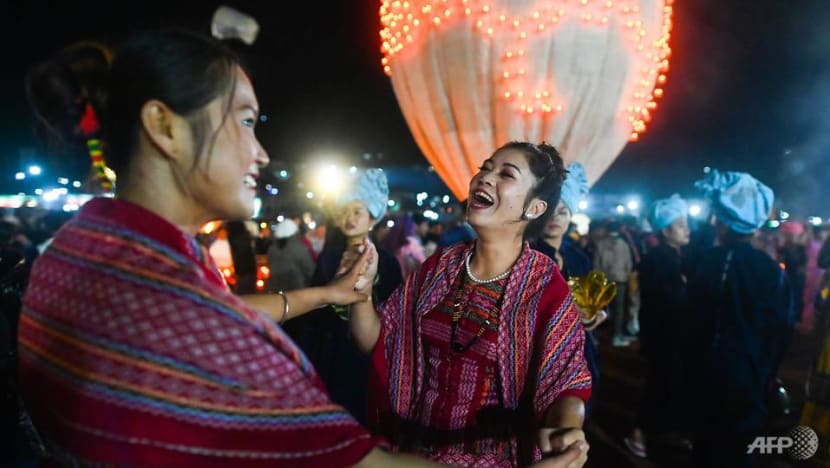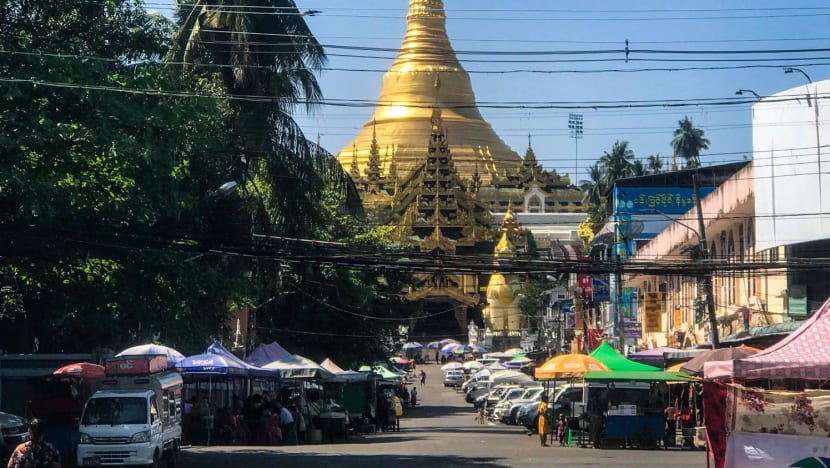Myanmar’s streets come alive again under the shadow of military rule
Myanmar’s military rulers plan to hold elections by the end of this year, portraying events like the Festival of Light as proof that life is returning to normal.

Participants dance as a hot air balloon attached with small lanterns is prepared to be released during the Tazaungdaing Lighting Festival at Taunggyi in Myanmar's northeastern Shan State. (Photo: AFP / Ye Aung Thu)

This audio is generated by an AI tool.
YANGON: Crowds are returning to the streets of Myanmar – but this time, not in protest.
This year, more people have been gathering at night markets and pagodas across the Southeast Asian nation to celebrate traditional festivities.
This marks a cautious revival of public life nearly five years after Myanmar's military seized control and ousted a democratically-elected government.
FESTIVAL OF LIGHT AMID DARKNESS
In the country’s largest city, Yangon, celebrations for Tazaungdaing – Myanmar’s Festival of Light – have drawn families back into the open.
The festival marks the start of the Buddhist robe-offering season and is a time to offer light in the form of releasing balloons into the air, symbolising the lifting of worries and wishes towards the heavens.
The night event, held across the city’s regional government office, was organised by the Myanmar military.
Festivities have not quite returned to pre-coup levels, when crowds once filled streets across the country.
But the return of dancing revellers, families lighting balloons, and people riding elephants are signs that some are beginning to lower their guard and return to public spaces.
“If we can engage with society during such festivals, our brain may produce happy hormones to help us cope with our daily lives,” said Aung Ko, a musician attending the event.
“I know conflicts are ongoing. But there are carnivals planned too. There's a difference between pure enjoyment and relaxing one's mind,” he added.
Scenes like these have slowly returned this year at events like night festivals and the Burmese New Year in April, when devotees began flocking back to the Shwedagon Pagoda – Myanmar’s most sacred Buddhist pagoda.
It is a stark contrast to 2021, when Myanmar’s streets were filled with protesters rallying against the coup. Flash mob demonstrations, once a hallmark of defiance, have largely disappeared.

Still, the opposition National Unity Government (NUG) told CNA that fading protests do not mean fading resistance.
“I don't see this as a sign that people are losing their will to fight for democracy. Because of the junta's continued violence and oppression, people have had to find other alternatives, often less visible ways to resist,” said NUG’s Foreign Minister Zin Mar Aung.
“This is another stage in the struggle. I do believe it's not the end of it,” she added.
STRUGGLES CONTINUE
While some find moments of joy in celebration, others continue to grapple with the challenges of daily survival.
A trishaw driver who wanted to be known as Ko Htet said he cannot enjoy himself as others do, as he needs to provide food, clothing and shelter for his family.
“I work two jobs. I’m now doing trishaw work as I can't do my other job on Sunday,” he told CNA while waiting for passengers on Yangon’s streets.
Away from the military-organised carnivals, everyday life is kept alive by small businesses and street vendors.

On the outskirts of Yangon, however, fear continues to shape how people live.
“The problem is the military patrol. They make people feel unsafe. The youths fear conscription. They don't go out as that could lead to trouble,” said Aung Kyaw, a resident of Shwe Pauk Kan township.
The Myanmar army has said it plans to hold elections by the end of this year, portraying events like Tazaungdaing as proof that life is returning to normal.
The junta has lost swathes of the country to pro-democracy guerrillas and powerful ethnic-minority armed factions, but has touted elections as a path to reconciliation.
Many see the festive celebrations as a controlled illusion - a way for the junta to project an image of normalcy under military rule.
For millions in Myanmar, hope remains simple: that one day, there will truly be light at the end of the tunnel.

















